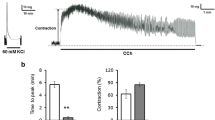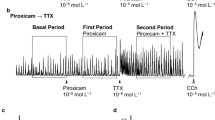Summary
The contractile effect of substance P was examined on the longitudinal muscle of isolated sections of the gut of cat, guinea-pig, pig, rabbit, and rat. Substance P caused contraction of all intestinal regions investigated, but there were marked qualitative and quantitative differences in the contractile responses to substance P. Low concentrations of substance P that did not cause tonic contraction (0.22–2.2 nM), increased the phasic longitudinal contractions observed in the ileum of cat, pig, and rabbit. Higher concentrations induced a tonic longitudinal contraction of the ileum, which in the cat, pig and rat was accompanied by facilitation and in the rabbit by inhibition of the phasic contractions. While in the ileum of guinea-pig and rabbit the maximal longitudinal contraction induced by substance P was equal to the maximal effect of acetylcholine, the maximal response to substance P was only about 50% of that to acetylcholine in the ileum of cat, pig, and rat. The jejunum, ilcum and colon of the rabbit responded to substance P and acetylcholine with similar maximal contractions, but the jejunum appeared to be most and the ileum least sensitive to substance P. The results suggest qualitatively and quantitatively different roles of substance P in the intestinal motility of different mammals.
Similar content being viewed by others
References
Bury RW, Mashford ML (1977) A pharmacological investigation of synthetic substance P on the isolated guinea-pig ileum. Clin Exp Pharmacol Physiol 4:453–461
Costa M, Cuello AC, Furness JB, Franco R (1980) Distribution of enteric neurons showing immunoreactivity for substance P in the guinea-pig ileum. Neuroscience 5:323–331
Costa M, Furness JB, Llewellyn-Smith IJ, Cuello AC (1981) Projections of substance P-containing neurons within the guinea-pig small intestine. Neuroscience 6:411–424
Edin R, Lundberg JM, Lidberg P, Dahlström A, Ahlman H (1980) Atropine sensitive contractile motor effects of substance P on the feline pylorus and stomach in vivo. Acta Physiol Scand 110:207–209
Franco R, Costa M, Furness JB (1979) Evidence for the release of endogenous substance P from intestinal nerves. Naunyn-Schmiedeberg's Arch Pharmacol 306:195–201
Holzer P (1982) An enquiry into the mechanism by which substance P facilitates the phasic longitudinal contractions of the rabbit ileum. J Physiol (London) 325:377–392
Holzer P, Lembeck F (1979) Effect of neuropeptides on the efficiency of the peristaltic reflex. Naunyn-Schmiedeberg's Arch Pharmacol 307:257–264
Holzer P, Lembeck F (1980) Neurally mediated contraction of ileal longitudinal muscle by substance P. Neurosci Lett 17:101–105
Holzer P, Gamse R, Lembeck F (1980a) Distribution of substance P in the rat gastrointestinal tract — lack of effect of capsaicin pretreatment. Eur J Pharmacol 61:303–307
Holzer P, Lembeck F, Donnerer J (1980b) Caerulein, substance P, serotonin and cholinomimetics induce rhythmic contractions of the intestinal circular muscle. Naunyn-Schmiedeberg's Arch Pharmacol 312:131–137
Holzer P, Emson PC, Iversen LL, Sharman DF (1981) Regional differences in the response to substance P of the longitudinal muscle and the concentration of substance P in the digestive tract of the guinea-pig. Neuroscience 6:1433–1441
Holzer P, Bucsics A, Saria A, Lembeck F (1982) A study of the concentrations of substance P and neurotensin in the gastrointestinal tract of various mammals. Neuroscience (in press)
Katayama Y, North RA, Williams JT (1979) The action of substance P on neurones of the myenteric plexus of the guinea-pig small intestine. Proc R Soc B 206:191–206
Leander S, Håkanson R, Sundler F (1981) Nerves containing substance P, vasoactive intestinal polypeptide, enkephalin or somatostatin in the guinea-pig taenia coli. Cell Tiss Res 215:21–39
Lembeck F, Gamse R (1977) Lack of algesic effect of substance P on paravascular pain receptors. Naunyn-Schmiedeberg's Arch Pharmacol 299:295–303
Pernow B (1953) Studies on substance P. Purification, occurrence and biological actions. Acta Physiol Scand Suppl:105:1–90
Schultzberg M, Hökfelt T, Nilsson G, Terenius L, Rehfeld JF, Brown M, Elde R, Goldstein M, Said S (1980) Distribution of peptide-and catecholamine-containing neurons in the gastrointestinal tract of rat and guinea-pig: immunohistochemical studies with antisera to substance P, vasoactive intestinal polypeptide, enkephalins, somatostatin, statin, gastrin/cholecystokinin, neurotensin and dopamine β-hydroxylase. Neuroscience 5:689–744
von Euler US, Gaddum JH (1931) An unidentified depressor substance in certain tissue extracts. J Physiol (Lond) 72:74–87
Author information
Authors and Affiliations
Rights and permissions
About this article
Cite this article
Holzer, P. Different contractile effects of substance P on the intestine of mammals. Naunyn-Schmiedeberg's Arch. Pharmacol. 320, 217–220 (1982). https://doi.org/10.1007/BF00510130
Received:
Accepted:
Issue Date:
DOI: https://doi.org/10.1007/BF00510130




